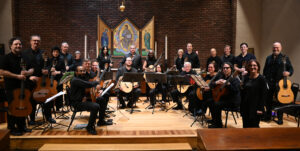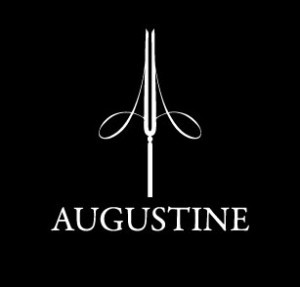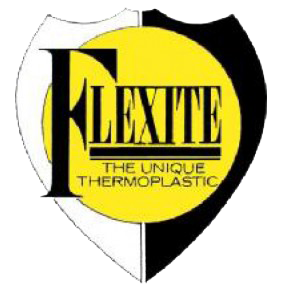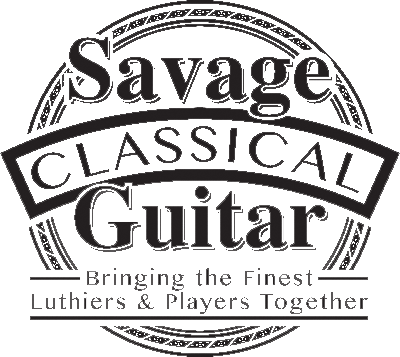by Julia Crowe
January 2004
David Spelman is the founder and executive director of the New York Guitar Festival (NYGF), which will take place this upcoming January 14 through February 3, 2004. He currently serves on the Board of Directors of the D’Addario Foundation for the Performing Arts, which funds music education, concerts, festivals, symposiums and research. Recently, the New York Guitar Festival debuted its 2-CD release, Guitar Harvest, Vol. 1, featuring guitarists from all music genres. The proceeds from the sale of this CD will support educational programs that bring free guitars and guitar lessons to public school kids in New York City. I had the chance to speak with David Spelman and learn more at length about this inspiring project.
Which came first? Producing the New York Guitar Festival followed by the Guitar Harvest CD, or was one a means of developing the other?
Back when the New York Guitar Festival was just a hazy ambition, I knew that in addition to producing concerts and broadcasts I wanted the festival’s mission to include a philanthropic component as well. The concerts began in the spring of 1999 and, soon afterwards, we launched an educational outreach project in partnership with the Kaufman Center’s Lucy Moses School. That pilot program was funded entirely by the D’Addario Foundation for the Performing Arts for the first three years. I believed from the beginning that benefit CDs could pay for our outreach work, but producing and finding a distributor for the first volume of the Guitar Harvest took a bit longer than expected.
It looks like you have gathered an eclectic bunch of musicians from different genres, i.e., pop/rock, blues, classical, for the Guitar Harvest album. Do you have any one vision or idea where the guitar is going?
Niels Bohr said: “Predictions are quite difficult — especially about the future.” I’ve always loved that! The truth is, I can hardly keep up with the instrument’s recent history. Every week I receive CDs from guitarists around the world. Of course, some of the stuff is truly dreadful, or just doesn’t especially tickle me, but some of the recordings are awesome. The level of playing in all the genres these days is extraordinary. The discs by classical guitarists are almost always very strong. I guess what I’m continually interested in is new compositions, new techniques, innovative collaborations, improvisation and traditional music from cultures I’m not familiar with. I have to say that working with WNYC’s John Schaefer — who is a walking encyclopedia of music — has been a tremendous boon to my musical awareness. John has really encouraged me to explore how the guitar and its cousins in the lute family are so central to traditional musics around the globe. How in Spain, Mali, Kenya, Cuba, India, and Vietnam an actual guitar tradition has developed, using essentially the same guitar that most of the musicians on Guitar Harvest play. And then, of course, there is the cross-fertilization among these traditions … don’t even get me started on that topic!
One of the things I really love about working with Schaefer is that we share the same ambition to expose audiences to music from different continents; from artists playing jazz, avant-garde, standards, classical, rock, blues, new age, folk … all these different things that on paper shouldn’t work together. We love surprising people and giving them an idea of what the guitar can do.
How did you get the guitarists to participate? Were there any pleasant connections, surprises or favorite experiences in putting this album together?
Having John Schaefer as a co-producer really opened a lot of doors. I think one of the first artists to agree to play on Guitar Harvest was Ralph Towner. I’m fairly sure I wouldn’t have been able to call Ralph out of the blue and make a successful pitch for being part of such an ambitious project. John has been hosting New Sounds on the airwaves for almost 20 years and in that time he’s built friendships with an incredible array of musicians.
What was interesting to me was how much respect some rock musicians have for classical guitar players. When I first explained the project to Andy Summers, I told him about the other artists who were already on board. I was very surprised when the name that really caught his attention was Benjamin Verdery. Andy told me how highly he thought of Ben’s recording of Bach’s 6th cello suite. I thought to myself — my god, this is the guitarist from The Police?! As I got to know Andy better, I discovered that he is in fact very knowledgeable — and passionate — about classical and flamenco guitar. I think he was the first person to turn me on to the great recording that Barrios made in the early 20th century. The next year, I had the great pleasure of finally introducing Andy to Ben backstage at our Guitar Marathon where both were scheduled to perform. Since then they’ve become good friends and have begun work on an album together.
In one of my first conversations with Vernon Reid, as soon as I told him that Guitar Harvest was to benefit public school kids, his answer was yes. When he asked about the other artists, I read him the list. While he knew most of them (many personally), the name that really jumped out at him was Russell Donnellon. Russell is a dear friend of mine who has been a busker (street performer) for many years. While he is one of the finest guitarists I have ever met, I was totally flummoxed when Vernon said: “Oh yeah, I know that cat; Russell is a great player.” Here was the guitarist from the multi-platinum selling, Grammy Award-winning band Living Colour, telling me that he heard Russell playing on the streets of New York City almost ten years earlier and still remembered him. I’ll never forget that.
There were many other great moments too — discovering that the jazz guitarists/composer Joel Harrison shared my love of Jerry Garcia or that Alex de Grassi was a huge fan of Jimi Hendrix (and played me an impromptu version of Angel over the telephone); sitting in the studio watching Frank Vignola get to the very heart of Django Reinhardt’s “Micro” in just one take; and mixing and mastering Gary Lucas’s moving tribute to his deceased friend and collaborator, singer Jeff Buckley, in the same studio where Buckley’s Grace was produced. If I tried to tell you all the stories, we’d be here all day …
Do you select guitarists mainly through referral and their recordings or do you trawl clubs and performance venues, too?
All of the above. I love going out to hear live music on the recommendation of friends, managers, agents, musicians, music critics, DJs, etc., but sometimes a package will just arrive in the mail (occasionally with exotic stamps) with some utterly mind-blowing music!
How did you go about selecting the artwork for the CD? I noticed the theme appears to be 1930s Dustbowl era photos with stark landscapes and maybe a guitarist huddled on a bench under a scrap of shade, as if to say, a guitar is all you need for comfort at the end of a long day.
I’ve always admired the subtle cover art from ECM Records and thought that black-and-white photography with minimal text might capture the “feel” I wanted. I originally thought I’d have to commission a photographer to get what I wanted, but on a whim a painter friend and I searched the internet using the words “guitar” and “harvest.” One of the first sites we came across was the Library of Congress. They have an amazing — somewhat overwhelming — collection of images, many of which have been digitized and are available for licensing. The Dustbowl era photos that we stumbled on mesmerized me and seemed to fit the quiet, comforting mood we were trying to achieve on the album (that is, with the obvious exception of the several robust tracks featuring electric guitar!). The folks at the Library of Congress were wonderful to work with and when they learned the project was not-for-profit, they waived the normal license fees for the images. So, I’m grateful to Google and the Library of Congress!
Volume 1 of Guitar Harvest mentions it is based on a theme of “teachers/mentors/inspirations.” What is your take on the current state of teaching young children these days?
From what I’m aware of, music and the arts are the first things to go whenever budgets are being cut in the public school system. I know there are some school systems in our country that have strong music programs, but here in New York City, music has really suffered over the past few decades. I’m told that a generation ago, in order to become certified in New York, all teachers had to demonstrate proficiency on a musical instrument. Needless to say, those days are gone. While I remain optimistic about the future of public school education, I suspect that as long as we have Bush in the White House, all we’re gonna get from Washington is empty “No Child Left Behind” rhetoric. I know that Bloomberg is working to improve our local schools, and I believe his heart is in the right place, but it’s too early to tell what the impact is going to be and I don’t really know where the arts and music fit into his vision.
I am very inspired by the work of groups like VH-1’s Save The Music and Little Kids Rock. Little by little there is progress being made in convincing the public that music is essential to children’s cognitive and behavioral development. The New York Guitar Festival’s outreach efforts may not change the world, but like the old saying goes: it’s better to light one candle than to curse the darkness. When the festival was just getting off the ground, something the playwright August Wilson said served as my mantra: “Art changes individuals, and individuals change society.” Giving free guitars and guitar lessons to school kids helps those kids grow and perhaps eventually give back to the city with their music.
What kind of guitars will be going to the school?
The first program that we began, in conjunction with the Lucy Moses School at the Kaufman Center in Manhattan, was taught by a classically-trained guitarist named Robert Olmstead. The kids he teaches at the Manhattan School for Children were given classical guitars that were purchased with a grant from the D’Addario Foundation for the Performing Arts. The D’Addario family (who have been making strings for nine generations) are extraordinarily generous and also understand that it is good business to encourage young people to learn to play music. It seems that the nylon strings of classical guitar are easier for beginning students than steel strings. The wonderful thing about Robert Olmstead is that in addition to his conservatory training (he’s a student of Michael Newman at Mannes) he’s also very much into rock, folk and bluegrass music. His broad knowledge — and love — of music really helps him communicate with the kids. I visited a class of his and the students were getting a little impatient with playing “Twinkle, Twinkle Little Star” and wanted to learn something “cool.” He decided to teach them “Louie, Louie” and the kids were really excited to be playing rock music for the first time! It was like a scene out of that recent film School of Rock.
Any plans to expand the program beyond the Lucy Moses school?
The original plan was to keep growing into other schools around the city. I soon realized that I don’t have the necessary skills to administer and grow an educational outreach program and that partnering with others who do is a smarter path for the New York Guitar Festival. We’ve decided that each new Guitar Harvest CD will benefit a different organization that is doing musical outreach work that we admire. This will allow me to focus on running the festival and producing recordings and leave it to real teachers and administrators to do what they do best.
What/who has been your own personal mentor/teacher and inspiration? How did you get into playing guitar?
Probably like a lot of people my age, the first music I loved was late ’70s rock music. While I liked the Sex Pistols, Patti Smith and The Clash — and even briefly played bass in a punk rock band — it was the Rolling Stones that really got me excited about music. I think the album Get Yer Ya Ya’s Out! convinced me that I simply had to play the guitar. It wasn’t long before my love of the Stones led me to discover blues artists like Robert Johnson, Muddy Waters and Howling Wolf. And around that time, I had a guitar teacher who suggested I listen to Coltrane’s A Love Supreme as well as albums by jazz guitar giants like Pat Martino, Jim Hall and Wes Montgomery.
While my parents loved classical music and there were albums by great artists such as Jean Pierre Rampal and Isaac Stern around our house, I didn’t encounter the classical guitar until years later. I think it was an interview with Michael Hedges (who had studied classical guitar and composition at the Peabody Institute) that made me think I should explore classical guitar. After high school, I moved to Santa Cruz, California, to work as a luthier’s apprentice and also enrolled in music classes at Cabrillo College. It was a 2-year community college but the music department there had some really amazing teachers — almost all of whom had Ph.D.s and were retired University of California professors. In fact, Lou Harrison even taught a Gamelan course there! Benjamin Verdery visited Cabrillo once to give a concert and masterclass and it really changed my life. His recital, that included Bach and Jimi Hendrix pieces, was totally awe-inspiring. And I was really fired up when I learned that he came to the classical guitar late too, like at 19 or 20 (my age at the time). At his masterclass he said that we should listen to some Bach every day. I was embarrassed that I didn’t own any Bach recordings so I ran out the next day and bought a recording of Pepe Romero playing two Bach partitas. One thing led to another, and after a year or two of ear training, theory classes, learning to sight-read and practicing five or six hours a day, I somehow got accepted to study at Peabody. So, it was goodbye sunny California, and hello Baltimore. I later finished my degree at the New England Conservatory in Boston, where I studied with David Leisner and Bob Sullivan, both of whom helped me tremendously.
As for guitars, I’ve owned a bunch of ’em over the years. My first classical guitar was made by a friend in Santa Cruz. It was one of the first ones he built and rather crudely made, but had gorgeous Brazilian rosewood back and sides and a really sweet, if quiet, tone. For many years I had a Fleta copy made by Richard Brune, but now I play a cedar top guitar by Thomas Prisloe from the early ’90s. I’ve never met him, having picked up the instrument at Guitar Solo in San Francisco a year ago, but if this instrument is typical of his work, I think he’s a terrific luthier. I believe the rosewood is from India, but to me it gives a lot of Brazilian rosewood guitars a run for their money.
I’ve also owned some great steel string guitars. I tend to like steel strings with a flat fingerboard and wide string spacing, similar to a classical set up. I find it easier for fingerstyle playing. My favorites would include a cedar top Lowdon from 1988 and a late ’60s small-bodied mahogany Martin. Oh, and then there are my lap steels — I’ve recently fallen in love with the sound of slide guitar. I have great old Rickenbacker (made of bakelite) from 1946 and also a ’60s Stella that I picked up recently for 25 bucks. It’s made of plywood, with funky open-gear tuners, but despite the lowly sum of its parts, it has an earthy, bluesy tone that hits your senses like a gulp of malt liquor. It’s not so hot for regular style guitar playing, but I had a Dobro-style nut made for it and it works perfectly for lap steel playing.
Do you have plans for Vol. 2 in the works?
Oh yes, I’m glad you asked. Guitar Harvest, Volume II: Live From the New York Guitar Festival is in production right now. Schaefer and I have a fantastic archive of recordings made since the first year of the festival and are working on final track selections and sequencing this month. I hope to have the artist clearances, mastering and graphic design complete before the new year and ready for release in early 2004. Volume II will benefit a terrific organization called Little Kids Rock that is dedicated to bringing free musical instruments and music instruction to public school children across the country.
I should also mention that Guitar Harvest, Volume III: Lift Every Voice is also getting off the ground. It will focus on music that has a spiritual foundation, including folk songs, hymns, spirituals and love songs. Music that is healing and meditative yet still searching and pushing at boundaries. Warm and comforting, not pandering beauty but beauty full of meaning and mood. I can’t say too much more about it, but stay tuned to www.newyorkguitarfestival.org for updates.
Who is playing at the New York Guitar Festival this year? Where may NYlon readers obtain more information about concert dates and tickets?
The full schedule of the festival is posted on our website, www.newyorkguitarfestival.org. I’d have to say that this year’s Guitar Marathon at the 92nd Street Y is going to be a hell of a lot of fun. Schaefer and I have put together a day-long program that traces the history of the guitar from Renaissance and baroque lute to flamenco and classical guitar to though African, blues, folk, jazz, rock and avant garde musics. Some of the players include Paul O’Dette, David Starobin, The Newman & Oltman Guitar Duo, Patty Larkin, Abdoulaye Diabate, Dominic Frasca, Steve Kimock, Dennis Koster, Russell Malone and David Torn. I hope to see you there!









